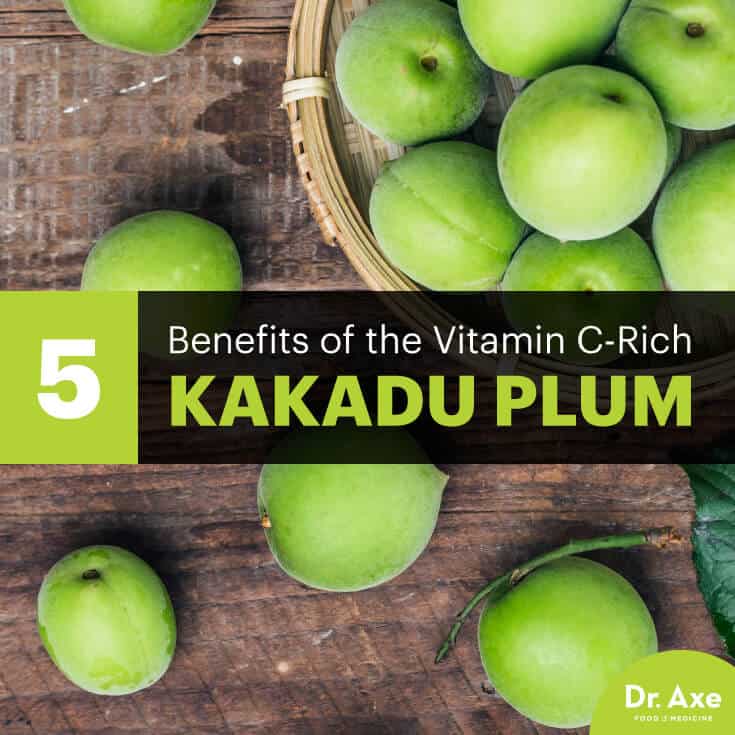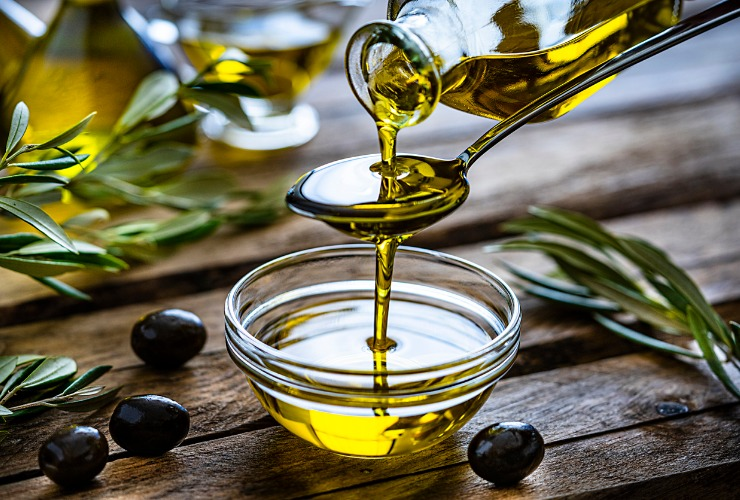Kakadu Plum
Australia is home to one of the most potent vitamin C foods known as the Kakadu plum. How much vitamin C does this superfruit contain? According to the Australian Government’s Rural Industries Research and Development Corp., the Kakadu plum has the “highest recorded level of natural vitamin C content of any plant in the world — more than 100 times that of oranges.” (1) Also called the gubinge or the billy goat plum, the kakadu plum is a flowering plant that’s more related to the almond than the plum. Unlike most fruits, the kakadu plum stays on the plant after ripening.
This delightful plum is similar to the size of an olive or cherry with a hard, woody seed that’s covered by a layer of edible fruit. It’s typically harvested in early March through June, depending on the monsoon season, and is most popular in jams, preserves, sauces, chutneys and juices, and is even used to flavor ice cream. However, it’s often found as a concentrate, much like you find acerola cherry, rose hips and black currant extracts, and as a powder supplement, packing anywhere from 150—450 milligrams of vitamin C per gram. That’s a lot of vitamin C, making it a true nutritional powerhouse, much like vitamin C-packed camu camu. The Kakadu plum may be perfect for anyone who struggles with eating enough fruits and vegetables get immune-boosting power of vitamin C. (2)
Kakadu Plum Benefits
1. Packs a Huge Antioxidant and Phytonutrient Punch
The Kakadu plum contains even more antioxidants than the blueberry, making it one of the most remarkable high-antioxidant foods on Earth. Going to head-to-head with the blueberry, it packs quite a comparative punch, providing 4.7 times more phenolic compounds and 10 times more potassium. Australian commercially grown fruits were examined, revealing the hydrophilic phytochemicals and antioxidants that they contain. The Kakadu plum showed much more total phenolic compounds than the blueberry and has been studied as a possible cancer-fighting food due to the phytonutrients it contains. (3, 4)
One study published in Food Chemistry gathered information of the various levels of phenolic compounds, vitamin C, sugars and antioxidant capacities of the Kakadu plum. The hydrolysable tannins and ellagic acid were identified as the major phenolic compounds and have placed this plum in the category that deems it safe and effective for use in the nutraceutical industry and for food processors. (5)
2. Protects Against Immune System Deficiencies
Vitamin C is one of the first nutrients to go when undergoing stress, smoking, drinking alcohol or engaging in other nutrient-depleting activities, such as endurance sports. When this happens, our immune systems are compromised, and a compromised immune system may be why you always catch that cold every time you travel. By loading up on vitamin C, you can prepare your defense system by boosting your immunity system before you come in contact with any cold-causing germs. (6)
3. Lowers Risk of Cardiovascular Disease
We know that fruits and vegetables are great choices for our health, and it’s the antioxidants they contain that gives them their amazing reputation. As such, fruits and vegetables have long been associated with lowering the risk for heart disease.
The European Prospective Investigation into Cancer and Nutrition study reviewed 9,187 men and 11,112 women, who all appeared to be healthy, aged 39 to 79 years. The results showed a decrease in heart failure with increasing plasma vitamin C, specifically, a “9% relative reduction in risk of heart failure after adjustment for age, sex, smoking, alcohol consumption, physical activity, occupational social class, educational level, systolic blood pressure, diabetes, cholesterol concentration, and body mass index, with similar result if adjusting for interim coronary heart disease.” (7)
Considering the Kakadu plum is the top vitamin C food around, it’s a great source to help protect against coronary heart disease.
4. Helps Fight Alzheimer’s
Edith Cowan University’s Foundation of Aging and Alzheimer’s Disease explains that the Kakadu plum contains antioxidant properties possibly up to seven times greater than curcumin, which is what places turmeric so high on the list of superfoods. The foundation states that the Kakadu plum has a protective ability that may make it even more powerful than turmeric.
How does this powerful plum become so amazing? When a plant is in an environment that’s harsh, it has to work harder to produce the antioxidants it needs to stay strong and thrive. These antioxidants get passed right on through to the the lucky recipient of the fruit. It’s this activity that’s thought to “protect brain neurons from toxic agents” and free radical scavenging, such as those that occur in Alzheimer’s patients. Free radicals ultimately kill brain cells. (8)
Since the antioxidants in the Kakadu plum fight free radical damage, this fruit may also work as a potential Alzheimer’s natural treatment.
5. Reduces the Appearance of Wrinkles
Vitamin C has the ability to reduce wrinkles and age spots, and that’s exactly why I recently shared an article containing my DIY Vitamin C Serum for the Face. Vitamin C provides collagen support, can reduce hyperpigmentation and can prevent skin changes caused by photoaging.
A study from the Beeson Aesthetic Surgery Institute in Indiana showed that with at least three months of use of a topical vitamin C application, significant results were visible in the reduction of wrinkles, along with skin texture and skin tone changes. (9) Additionally, this plum contains trace minerals and antioxidants that nourish and invigorate the skin, including vitamin E, zinc, iron, folate and lutein, all of which can help prevent premature aging.

Kakadu Plum Nutrition
When you think of the plum, you likely see the plump, fleshy one that’s most common in our markets today, but the Kakadu plum looks much different. Even though it has a fleshy skin that surrounds a woody pit, it’s smaller, closer to the size and texture of a cherry and shaped more like an olive.
So how does Kakadu plum nutrition stack up vs. regular plum benefits? Let’s take a look.
A 100-gram serving of Kakadu plum contains about: (10)
- 21.3 calories
- 0.8 gram protein
- 0.5 gram fat
- 7.1 grams fiber
- 2,907 milligrams vitamin C (4,845 percent DV)
- 0.9 milligram copper (45 percent DV)
- 2.4 milligrams iron (13 percent DV)
- 40 milligrams magnesium (10 percent DV)
- 261 milligrams potassium (7 percent DV)
- 62 milligrams calcium (6 percent DV)
- 0.7 milligram zinc (5 percent DV)
A 100-gram serving of a standard raw plum contains about: (11)
- 46 calories
- 11.4 grams carbohydrates
- 0.7 gram protein
- 0.3 gram fat
- 1.4 grams fiber
- 9.5 milligrams vitamin C (16 percent DV)
- 6.4 micrograms vitamin K (8 percent DV)
- 345 IU vitamin A (7 percent DV)
- 157 milligrams potassium (4 percent DV)
How to Use a Kakadu Plum
The Kakadu plum can be used in many ways as previously noted, but the most popular use today is in morning smoothies and breakfast bowls or in chili sauces and jams. It can make a great addition to fruit salads, yogurt and fresh salads as well.
It’s usually found as a powder or juice. Juicing can be a lot of trouble and not yield as many results due to its fibrous nature; however, extracts can be purchased that have gone through the process of solid-liquid extraction. (12)
Here’s a Kakadu plum recipe to try:
Overnight Kakadu Plum Superfood Chia Bowl Recipe
Serves: 1
INGREDIENTS:
- 1 small banana
- 1 teaspoon local honey (optional)
- 1 cup plain almond milk
- 1 teaspoon freeze-dried or 1/3 cup finely chopped fresh Kakadu plum
- 2 tablespoons chia seeds
- ¼ cup gluten-free oats
- 1 scoop of your favorite protein or vanilla bone broth
DIRECTIONS:
- In a bowl or mason jar, layer chopped or sliced banana, chia seeds, Kakadu plum, oats and the protein.
- Then pour in the almond milk.
- Place lid on jar and place in the fridge.
- After a half an hour, turn it upside down overnight. Make sure the lid is on tight.
- The next morning, give it a good stir and it’s be ready to go.
Here are a couple more Kakadu plum recipes:
Kakadu Plum History
The tree from which this plum is grown, scientifically named Terminalia ferdinandia, grows in Northwestern Australia. In addition to Kakadu plum, common names include billy goat plum, green plum, wild plum, murunga, manmohpan and marnybi. (13)
The Kakadu plum has been used as a traditional medicine for the treatment of numerous ailments for thousands of years. The Australian Aboriginal people would take the fruit on long hunting journeys and considered it as medicine more than food. The inner bark of the tree was used to treat a variety of skin disorders and infections, including wounds, sores and boils.Recent studies have reported antibacterial benefits as well.
This special plum has a pale olive-green, oval shape with a central wooden core. It’s fibrous, containing a tart and bitter taste. The Kakadu plum is considered a “gift of the Dreamtime by Aboriginal culture” and has been noted as a very an important bush food in northern Australia. Tradition shows that the fruit and seed were eaten raw — however, the fruit contains a sap that was commonly roasted while the bark was boiled. Indigenous people would use the sap and bark to treat skin conditions and sores and would make a tea for colds and flu.
It’s mainly a wild harvest, which is a challenge for the industry in order to make it profitable. Kakadu plum can be eaten fresh off the tree and is most often seen as a flavoring and supplement in jams, preserves and sauces, sports drinks, and beauty products due to its high content of vitamin C.
Kakadu Plum Risks
Though there are no reports of any negative side effects to date, like any new food, if you experience an allergic reaction, stop consumption or use immediately.
Final Thoughts on the Kakadu Plum
The Kakadu plum is a great option due to its vitamin C potency alone — however, the antioxidants it contains offer some amazing benefits. Consider putting it into your diet a few times a week. It may be perfect to help boost the immune system before, during and after travel, and as the most vitamin C-rich food on the planet, the health benefits are more than enough to enjoy this superfruit.



Hiv disease for the last 3 years and had pain hard to eat and cough are nightmares,especially the first year At this stage, the immune system is severely weakened, and the risk of contracting opportunistic infections is much greater. However, not everyone with HIV will go on to develop AIDS. The earlier you receive treatment, the better your outcome will be.I started taking ARV to avoid early death but I had faith in God that i would be healed someday.As a Hiv patent we are advise to be taking antiretroviral treatments to reduce our chance of transmitting the virus to others , few weeks ago i came on search on the internet if i could get any information on Hiv treatment with herbal medicine, on my search i saw a testimony of someone who has been healed from Hiv her name was Achima Abelard and other Herpes Virus patent Tasha Moore also giving testimony about this same man,Called Dr Itua Herbal Center.I was moved by the testimony and i contacted him by his Email.drituaherbalcenter@gmail.com We chatted and he send me a bottle of herbal medicine I drank it as he instructed me to.After drinking it he ask me to go for a test that how i ended my suffering life of Hiv patent,I'm cured and free of Arv Pills.I'm forever grateful to him Drituaherbalcenter.Here his contact Number +2348149277967...He assure me he can cure the following disease..Hiv,Cancer,Herpes Virus,Epilepsy,Hepatitis,Parkinson disease.Diabetes,Fibroid...
ReplyDelete